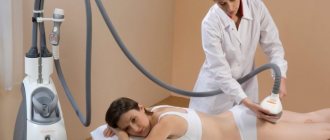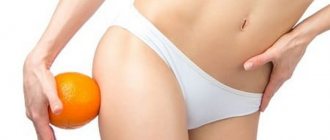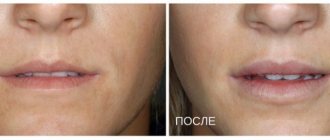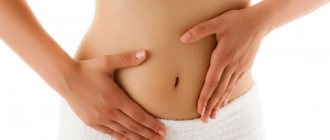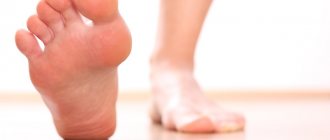04/04/2018 Category: Cellulite Author: Ekaterina Panina
Cellulite is the #1 problem for most women. However, not everyone understands that the skin condition can worsen further. With each stage of development, the pathology becomes more and more difficult to treat and ultimately only surgery can help. To avoid the latter, it is necessary to detect the problem in time. To do this, in turn, you should carefully study the main characteristics of each stage of cellulite development.
- Development mechanism
- Reasons for development
- Video: what is cellulite and why does it occur?
- Stages of development
First (initial)
- Second
- Third
- Fourth (last)
What is cellulite
Cellulite is a pathology of adipose tissue caused by a violation of cell structure. Such changes are usually caused by a weakening of blood flow to the dermis. From the outside, cellulite looks like small protrusions and pits that form an unaesthetic relief. Because of the latter, the pathology acquired a second name - “orange peel”.
Interestingly, the name “cellulite” comes from the Latin word cellula. The latter is translated as “cell”.
“Orange peel” can provoke not only psychological, but also physical discomfort in a woman. The thing is that over time, a harmless defect in appearance can develop into a serious illness. The latter is difficult to treat, often with the help of a surgeon.
To find out if you have cellulite, just squeeze the skin where it appears.
To avoid the occurrence and development of “orange peel”, it is recommended to test your own skin from time to time for the presence of pathology. To do this, you should strongly compress the dermis at the suspected site of cellulite formation. There is no need to worry if the surface is smooth. Otherwise, it is necessary to begin taking measures to eliminate the “orange peel” and prevent its further development.
Interestingly, cellulite has been studied by scientists for several decades. Experts assure (according to the journal of the American Medical Association JAMA in 1978) that pathology is not a disease. Scientists say it is caused by impaired metabolism, but no drugs have yet been created against its development.
Signs
Lipodystrophy of this type develops in stages.
In accordance with the stage of progression of the problem, its clinical picture also appears:
- The first degree is characterized by a slight malfunction of the lymphatic and circulatory systems.
This condition is not considered pathological, and almost every person faces it. Bruises easily form in damaged areas. A cosmetic defect can disappear on its own if you lead a healthy lifestyle and follow proper nutritional rules. - In the second degree, the resulting irregularities on the surface of the skin become noticeable with traditional “pinching.” The skin acquires a marbled tint. This skin color is due to slight swelling of the tissues. The problem can be quickly resolved with physical exercise.
If measures are not taken to combat stage 2 lipodystrophy, swelling will interfere with normal blood supply to tissues. In this case, cellulite will progress further.
- At the next stage, the bumpiness of the epidermis will be noticeable without compression of the skin.
The more the disease develops, the more metabolic processes in the tissues are disrupted and the more clearly the clinical picture of the pathology appears. In women, “orange peel” is observed mainly in the thighs and buttocks, on the sides and abdomen.
Development mechanism
Let us remember that cellulite is a change in the structure of adipose tissue. The affected segments of the latter no longer take an active part in the overall fat metabolism of the body. In this regard, the connective tissue that is located around the fat cells begins to grow. This process happens quite quickly. As the tissue grows, it compresses and pushes fat-filled cells toward the surface of the dermis. This is the reason for the formation of small tubercles and depressions.
Fat cells are located differently on healthy and cellulite-affected skin
The emerging segments do not allow substances responsible for the breakdown of fats in the body to penetrate cells affected by pathology. In this regard, the latter accumulate more and more toxic compounds and fat. Thus, the bumps increase in size, and the surface of the dermis looks increasingly loose and flabby.
It should be noted that cellulite has nothing to do with being fat. Pathology is only a consequence of impaired cellular metabolism, due to which fat cannot leave the segments in which it accumulates. You must have noticed that “orange peel” occurs in both obese and thin women.
Most often, cellulite develops over years. That is why it is important to determine the presence of pathology in the early stages. This way you can quickly and painlessly eliminate unsightly relief. Of course, there are exceptions. The latter often manifest themselves in the form of accelerated development and spread of “orange peel” skin. In this case, a woman who has just discovered signs of cellulite realizes after a few months that her body has become flabby. Typically, such phenomena occur during pregnancy or other hormonal changes.
Nuances
Cellulite is an infectious disease of the skin and subcutaneous tissues, which is characterized by fever, erythema, swelling and pain.
Constant leg pain can impair lymphatic drainage, leading to chronic leg swelling.
It must be remembered that erysipelas is an inflammatory form of cellulite, which differs from other forms of cellulite by the pronounced involvement of lymphatic tissue (red cords of lymphangitis), raised and clearly defined boundaries of the lesion.
In the tabloid literature, the term “cellulite” is more often used by cosmetologists and is associated by them with various changes in subcutaneous adipose tissue, leading to changes in skin texture.
Cellulitis is a bacterial infection most commonly caused by group A Streptococcus and Streptococcus aureus. Many other bacteria can also cause cellulite.
Changes in the skin and subcutaneous fat caused by impaired lymphatic drainage and microcirculation are called cellulite. Cellulite begins to appear from minor aesthetic changes in the skin to severe disruption of the functioning of the limb and the appearance of pain.
Reasons for development
The main reasons for the development of cellulite are:
- Physiological characteristics of the female body. It is known that representatives of the fair sex are most susceptible to the appearance of “orange peel”. The reason for this is the different structure of connective tissue. In women, the latter is more extensible and loose. This is primarily due to the possibility of having offspring, because during pregnancy a girl’s body volume increases noticeably in a relatively short time.
Fat cells in men and women are located differently, which explains the predisposition to cellulite in the fair sex - Hormonal changes. In this case, the deviations for representatives of different sexes will be different: For women. The hormone that directly affects the possibility of cellulite formation is estrogen. The latter is able to activate the sebaceous glands, increase the concentration of fluid in tissues, relax muscles, prevent the production of soluble collagen and increase vascular permeability.
- In men. Representatives of the stronger sex also have estrogen. The latter performs important functions in a man’s body: it maintains the level of “good cholesterol” at the proper level, improves brain activity and helps normalize the functioning of the heart and blood vessels. But the female sex hormone is beneficial only when its concentration in the blood is 10 units less than the same value of testosterone.
- An abundance of harmful foods in the diet. These include chips, soda, sweets and much more.
Hamburgers, fries and other unhealthy foods are bad for the health of the dermis
If there is a lack of protein in the body, cells cannot renew themselves in a timely manner.
For normal skin function, you need to consume complex carbohydrates daily.
The presence of the right fats in the diet ensures normal thyroid function.
To prevent the development of cellulite, try not to use frying pans or deep fryers.
Fruits and vegetables should be present in the diet daily
To avoid cellulite, you should eat small portions
Excessive salt intake leads to edema
Caffeine disrupts the water-salt balance in the body
An adult should drink about 2 liters of clean water per day
- Alcohol. Alcoholic drinks, especially strong ones (whisky, cognac, etc.), have a high calorie content. In addition, alcohol increases the concentration of estrogen in the blood.
Excessive alcohol consumption increases the amount of estrogen in the blood
Using tobacco products reduces the rate of collagen production
Even an ordinary walk with the dog is suitable as physical activity.
Wearing high heels helps slow blood flow in the legs
Tight clothing slows down blood circulation in tissues
It is recommended to relieve stress after a hard day at work in a harmless way, such as taking a bath.
- Eating disorders. When suffering from anorexia or bulimia, sudden changes in body weight occur.
Habits that will help you get rid of cellulite
To stop the development of lipodystrophy, you need to change some habits:
- reduce your coffee consumption to one small mug in the morning. The rest of the time, drink green tea, natural (not packaged) juices, fruit drinks, herbal decoctions with diuretic properties;
- if you want to drink alcohol at the holiday, you should give preference to dry red wine (no more than 150 g);
- quit smoking;
- do not consume a lot of fatty dairy products (ice cream, yogurt, cottage cheese);
- include sea fish and fresh vegetables in your diet;
- do not wear high-heeled shoes or tight clothing every day;
- change body position more often, get out of the habit of sitting cross-legged.
A good way to remove cellulite on the butt is to stop using the elevator and walk up the stairs home.
Stages of development
There are four main stages of cellulite. They all have certain characteristics.
First (initial)
The first stage is characterized by the absence of visible relief. The skin looks smooth, but the connective tissue has already begun to displace fat cells. You can understand that cellulite has begun to develop by the following signs:
- increase in volume of the buttocks for no apparent reason,
- the appearance of sagging skin,
- the occurrence of swelling.
To make sure that the “orange peel” has begun to form, firmly squeeze the skin in the suspected problem area. If the relief is already visible, then it’s time to take action. In addition, under certain lighting, bumps and depressions will be visible without additional manipulation.
At the first stage of cellulite, the relief is visible only when the skin is compressed
As a rule, swelling and an increase in body volume are associated with slagging in the body. The latter most often appears due to the fact that fat segments with an altered structure release toxic substances into the intercellular space. Due to the large number of incoming toxins, the lymph does not have time to remove them. This is the main reason for fluid retention in tissues. Constant swelling leads to compression of the lymph nodes, which makes the situation even worse. The first stage is different in that 40% of the accumulated fluid is removed from the intercellular space quite simply. That is why it will not be difficult to fight cellulite at the initial stage of its development.
Most often, at the first stage of cellulite, it is enough to include any physical activity in your life, start eating more healthily, regularly visit the sauna or bathhouse, and also perform some cosmetic procedures:
- wraps,
- scrubbing,
- masks,
- compresses.
At the first stage of cellulite development, it will be enough to use scrubbing and other cosmetic procedures.
Lymphatic drainage can be noted as a radical method. The latter, provided you maintain an active lifestyle, allows you to forget about the problem for a long time.
Second
The second stage is characterized by a noticeable relief on the skin. When you run your finger over problem areas, you can clearly feel the bumps and depressions. However, if you don’t look closely, you may not see the “orange peel” on the surface of the dermis. In this case, the liquid almost never leaves the intercellular space. In addition, the skin begins to gradually lose its sensitivity.
At the second stage of development, cellulite is visible to the naked eye.
At the second stage, cellulite is fought with:
- a strict diet excluding fatty and sweet foods;
- physical activity;
- cosmetic procedures: wraps, masks, etc.;
- massage: vacuum, honey, spoon, etc.;
- water procedures: contrast showers, baths, etc.
One of the main ways to combat cellulite in the second stage of its development is body wraps.
Third
The third stage of cellulite is characterized by pinching of the arteries and oxygen starvation of the tissues. At this stage, the “orange peel” is clearly visible on the surface of the skin. In addition, due to the lack of oxygen supply, the connective tissue actively grows, forming a network resembling a honeycomb. Each cell is a cluster of cells with fat. It is also worth noting that the skin almost completely loses sensitivity and becomes cold to the touch. It gets to the point that in the winter season, areas affected by stage 3 cellulite are difficult to warm up. Also signs of this stage are:
- Lack of response to pinch. If you do the latter with healthy dermis, it will hurt. If you pinch the skin affected by the pathology, you will feel almost nothing. The fact is that in problem areas the nerve endings are compressed, so their reaction to a pinch is absent or practically not manifested.
- Loss of skin mobility. Connective tissue fibers are “sucked” on one side to the muscles and the other to the dermis. In this regard, the latter becomes practically immobilized and during various manipulations (stroking, etc.) most often remains in its place.
The third stage of cellulite is characterized by noticeable relief and weak sensitivity of the skin.
The third stage of cellulite is not easy to treat. The fact is that lymphatic drainage, cosmetic procedures and dietary changes are practically ineffective in this case. Overgrown connective tissue will not allow you to improve the appearance of your skin even with significant weight loss. Most often, the following methods are used to eliminate cellulite at the third stage:
- massages: vacuum, manual, spoon and dry rubbing;
- electrolysis,
- ultrasound.
One of the main methods of getting rid of cellulite at the third stage of its development is vacuum massage using medical cups
. In addition to radical measures, it is necessary to adhere to a strict diet, take anti-cellulite baths and exercise. All this will help you achieve your desired goal faster.
Fourth (last)
The fourth stage of cellulite is characterized by:
- Conspicuous skin texture, visible even under clothing. The skin looks like swollen yeast dough, not an orange peel.
- “Fossilize” problem areas. The skin becomes very hard to the touch.
- Areas affected by cellulite are blue.
Cellulite at the fourth stage is characterized by a strongly pronounced skin texture.
To understand that cellulite has entered the fourth stage, perform a simple test: strongly squeeze the skin in the problem area, and then sharply release it. If you feel unbearable pain, it means that the “orange peel” is at the last stage of development.
In this case, cosmetic procedures, massage and diet will not help. But it is simply necessary to fight cellulite at the fourth stage, since various types of inflammation and even gangrene can become possible complications. The only truly effective method of getting rid of the “orange peel” at the last stage of its development is liposuction. This is a serious surgical operation, but for the sake of a healthy dermis you will have to take even such measures. However, you should not assume that liposuction will completely rid you of cellulite. The latter will remain after the operation, but in a less pronounced form: at the first, second or third stage.
At these stages of orange peel development, you can combat the problem using the methods described above.
Treatment
Indurative cellulite appears at stages 4-6 of the development of venous insufficiency, when the main cause of varicose veins is almost impossible to establish. Therefore, treating this disease is quite difficult.
The treatment uses elastic compression, phlebotonics (Phlebodia, Detralex, Diosmin, Vasoket, Diovenor, Daflon), anti-inflammatory drugs (Nise, Voltaren), regenerating agents (Solcoseryl, Actovegin), according to indications - Thrombo ACC, Trental.
At the acute stage, in the presence of a bacterial infection, antibiotics are used. Infusion therapy is also used - intravenous drip administration of Actovegin, Reopliglyukin.
If the dilated veins causing this complication are eliminated, sclerotherapy or surgical treatment may be performed.
For local treatment, corticosteroid creams, ointments or gels are prescribed. The most commonly used ointments are: Fluorocort, Polcortolon, Lorinden S, Lorinden A, Sinaflan, Elokom, Sinalar, Flucinar, Triamcinolone.
Heparin preparations containing a high dose of heparin (Thrombophob, Hepatrombin, Trombless) have a great therapeutic effect. These products should be applied about twice to clean skin daily, and then rubbed into the affected area for three minutes. After 20 minutes, you should put on a compression stocking or stocking.
The most effective of the gels is Lyoton 1000 based on heparin, which has a beneficial effect on microcirculation in the skin and subcutaneous tissue and has a transdermal effect.
Edema cellulite is similar in symptoms to soft cellulite, but with it a larger amount of fluid is formed in the tissues. Most often, “orange peel” appears on the legs and develops along with varicose veins. Sometimes a cosmetic defect appears together with hard or soft cellulite.
The edematous form of the disease is not only an aesthetic problem, but also a medical one.
With this pathology, changes in skin structures cause stagnation in the tissues and lead to fluid retention in them.
How to properly treat edematous cellulite
Treatment of edematous cellulite requires an integrated approach.
You will not be able to completely get rid of the problem using home remedies alone.
Therapy should include:
- use of cosmetics;
- gymnastic exercises;
- salon procedures.
Beauty care
It is important not only to choose the right product, but also to use it skillfully. All lotions and creams for orange peel are rubbed into the skin after taking a hot shower. This promotes better absorption of the active components of the cream into the skin, as its pores expand under the influence of heat.
The most effective will be those preparations that contain clay or seaweed.
It would be good if the active components of the product were plant extracts of horsetail, horse chestnut, and hawthorn.
It is necessary to pay attention that the cream for edematous cellulite contains vitamins A, B, C, E. They allow you to stimulate tissue regeneration and accelerate the removal of excess fluid from them.
The list of the most effective remedies for edematous cellulite includes:
- Elancy drainage balm;
- Thalassothys decongestant concentrate;
- gels to eliminate heavy legs Frisson de Vervein;
- Scholl foot health cream.
The best effect from cosmetic products can be achieved when used during a massage. Otherwise, the cream will only temporarily improve the condition of the skin.
Gymnastic exercises
Special exercises allow you to saturate tissues with oxygen and improve metabolic processes in the body. For edematous lipodystrophy, race walking, cycling and swimming will be useful.
The following exercises will help tone your skin:
- Lateral leg raises.
The exercise is performed lying on your side, with your head resting on your arm bent at the elbow. The lower limb lying on top is raised as high as possible and then returned to its original position. Carry out 30 approaches on each side. - Warm-up for the inner thighs.
Starting position as in the previous exercise. Swings are performed with the leg located closer to the floor. The limb is raised as high as possible above the floor surface. - Warm-up for the upper legs.
Starting position - lying on your stomach, hands resting on the floor. The legs are raised alternately to their maximum height. The exercise is performed 15 times for each leg. - An exercise to strengthen the gluteal muscles.
A man stands with his back to a chair and leans his hands on it. From this position alternate swings of the legs are carried out. The minimum number of repetitions is 30 times. - Bike.
Lying on his back, a person pedals in the air. The exercise time is unlimited.
Salon treatments
Procedures performed in beauty salons will allow you to quickly and reliably eliminate edematous cellulite:
- Endermology.
During the procedure, the deep layers of the skin are affected. Using a special attachment, tissues are captured and processed with special rollers. - Laser liposuction.
The essence of the method is the effect of a light beam on the subcutaneous fat layers. As a result of this, excess fluid evaporates from the cellular structures and is removed outside. The procedure is performed every 4 years. - Mesotherapy.
Intramuscular injections are performed with drugs that help burn fat and evaporate excess fluid from tissues. - Ultrasound therapy.
The procedure allows you to smooth out problem areas of the body by correcting connective and fatty tissue, as well as improving microcirculation in cells. - Subcision.
Used to treat advanced stages of edematous cellulite. The essence of the method is cutting off abnormal growths of connective tissue.
